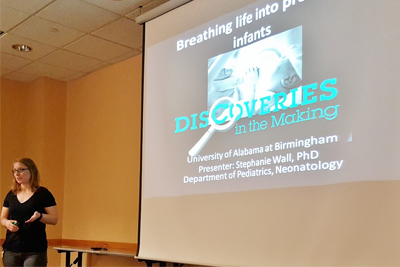Stephanie Wall, is a post-doctoral student in the UAB Department of Pediatrics with a research focus in neonatal lung development.
In Stephanie’s Discoveries in the Making Talk at Hoover Library on March 14, 2016 she revealed how complex “Breathing Life into Premature Babies” can be. Premature babies hastephaniewallve underdeveloped lungs requiring high-oxygen treatment for their survival, yet this life-saving treatment further compromises the baby’s own natural defenses. Innate immune and antioxidant systems are severely weakened compared to full-term infants. Oxygen therapy in pre-term infants can lead to increased oxidative stress and more severe conditions such as long-term lung disease, or Bronchopulmonary Dyplasia (BPD). Stephanie wants to know “if we kick-start the baby’s natural antioxidant system [early], can we prevent this damaging oxidative stress produced in the baby’s lungs due to therapeutic oxygen treatment?” She is using an FDA approved gold compound that can trigger the body’s own natural antioxidants to test this question, and has promising results in a mouse model of premature lung development.
 Each year roughly half-a-million babies are born premature, or before 37 weeks of gestation. Incredibly, at 22 weeks, halfway through gestation, modern incubators supply heat, oxygen (O2) supplied through breathing tubes, special lighting and additional therapeutics capable of providing life support in the clinic. A critical factor for survival at this stage is the lung. In the womb, the baby receives O2 through the umbilical cord as the mother’s body allows for gas exchange and O2 to reach the fetus.
Each year roughly half-a-million babies are born premature, or before 37 weeks of gestation. Incredibly, at 22 weeks, halfway through gestation, modern incubators supply heat, oxygen (O2) supplied through breathing tubes, special lighting and additional therapeutics capable of providing life support in the clinic. A critical factor for survival at this stage is the lung. In the womb, the baby receives O2 through the umbilical cord as the mother’s body allows for gas exchange and O2 to reach the fetus.
Why would premature lungs need to be treated with such high concentrations of O2?
At the pre-alveolarization stage of development, lungs are not equipped to allow normal gas exchange into the bloodstream. Therapeutically increasing O2 helps force this gas from the lungs into the bloodstream, and get oxygen to the rest of the body.
Room air contains approximately 21% oxygen, four times of that in the womb, and therapeutic O2 is drastically increased from 21% to anywhere up to 100%. Therefore, oxygen therapy is actually a contributing factor for the development of BPD, as increased oxygen levels lead to oxidative stress via excess generation of damaging reaction oxygen species (ROS). Antioxidants combat these ROS, but in pre-term infants, their own antioxidant system has not yet developed and is severely compromised due to therapeutic O2 treatment. Stephanie likened this process to an out of control fire (excess ROS) that requires firefighters (antioxidants) to be tamed and reduce harm.
Aruthioglucose (ATG) is an FDA approved gold compound used to treat rheumatoid arthritis, and current scientific literature show that ATG is protective against oxidative stress. Stephanie wanted to know if ATG treatment in a mouse model of premature lung development could reduce damage caused by therapeutic O2 levels. Her results are very promising and show that ATG treated mice exposed to high O2 appear similar to mice exposed to room air (control condition) suggesting ATG rescues alveolar development.
How is ATG helping?
Stephanie and colleagues think ATG acts as a booster for the mouse’s natural antioxidant system and “calls the firefighters in earlier to protect against oxidative stress caused by high O2 therapeutic conditions used to treat premature lungs.” In essence, ATG may help “prime” the babies own natural antioxidant system to provide lung protection. Exactly how ATG is protective and what cellular pathways it is using to do so is what Stephanie’s future studies aim to address.